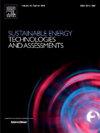基于 "资源-需求 "平衡的低碳区域综合能源系统适宜性匹配评估
IF 7.1
2区 工程技术
Q1 ENERGY & FUELS
Sustainable Energy Technologies and Assessments
Pub Date : 2024-11-21
DOI:10.1016/j.seta.2024.104099
引用次数: 0
摘要
综合能源系统(IES)以其多能互补、绿色高效的优势脱颖而出。本文旨在提供一种基于 "资源-需求 "平衡的低碳区域综合能源系统适宜区选址实用模型。建立了 "资源-需求 "适宜性匹配分析指标体系。利用前景理论和变精度粗糙集理论,分别对专家打分的决策偏好和认知模糊影响进行修正,得到合理的主观权重。然后,利用熵值法得到客观权重,并通过博弈论权重法得到最优组合权重。最后,本文建立了由相似度匹配度、数值匹配度和适宜度匹配度三个子模型组成的 "资源需求 "适宜度匹配模型。对北京市 16 个区域进行了实证研究,结果表明,"资源需求 "的数值匹配度从中心城区向周边区域逐渐降低。大部分地区的相似性匹配度达到最高范围(0.776,1.00)。适宜性匹配度为满分的区域有 4 个,为优的区域有 7 个,为良的区域有 1 个,为差的区域有 4 个。本文建立的适宜性匹配模型可以指导能源项目决策者选择具有较大发展潜力的地区发展 IES。此外,通过调整相似度匹配系数和数值匹配系数,可以满足决策者对 "资源-需求 "平衡的相似度匹配程度和数值匹配程度的多样化需求,为能源项目规划决策提供支持。本文章由计算机程序翻译,如有差异,请以英文原文为准。
Suitability matching evaluation of the low-carbon regional integrated energy system based on the “resource-demand” balance
The integrated energy system (IES) stands out due to its advantages of multi-energy complementarity, green and efficiency. This paper aims to provide a practical model for suitable region site selection of low-carbon regional IES based on the “resource-demand” balance. A “resource-demand” suitability matching analysis indicator system is established. By using prospect theory and variable precision rough set theory, the decision-making preferences and the cognitive fuzziness influence of expert scoring were corrected respectively, and reasonable subjective weights were obtained. Then, the objective weights are obtained using the entropy method, and the optimal combined weights are obtained through the game theory weighting method. Finally, this paper establishes a “resource-demand” suitability matching model consisting of three sub models: similarity matching degree, numerical matching degree, and suitability matching degree. An empirical study is conducted on 16 regions in Beijing, and the results show that the numerical matching degree of “resource-demand” gradually decrease from the central urban regions to the surrounding regions. The similarity matching degree in most regions reaches the highest range (0.776,1.00). There are 4 regions with a suitability matching rating of perfect, 7 regions with a rating of great, 1 region with a rating of good, and 4 regions with a rating of poor. The suitability matching model established in this paper can guide energy project decision-makers to select regions with greater potential for the development of IES. In addition, adjusting the similarity matching coefficient and numerical matching coefficient can meet the diversified needs of decision-makers for the similarity matching degree and numerical matching degree of the “resource-demand” balance, providing support for energy project planning decisions.
求助全文
通过发布文献求助,成功后即可免费获取论文全文。
去求助
来源期刊

Sustainable Energy Technologies and Assessments
Energy-Renewable Energy, Sustainability and the Environment
CiteScore
12.70
自引率
12.50%
发文量
1091
期刊介绍:
Encouraging a transition to a sustainable energy future is imperative for our world. Technologies that enable this shift in various sectors like transportation, heating, and power systems are of utmost importance. Sustainable Energy Technologies and Assessments welcomes papers focusing on a range of aspects and levels of technological advancements in energy generation and utilization. The aim is to reduce the negative environmental impact associated with energy production and consumption, spanning from laboratory experiments to real-world applications in the commercial sector.
 求助内容:
求助内容: 应助结果提醒方式:
应助结果提醒方式:


